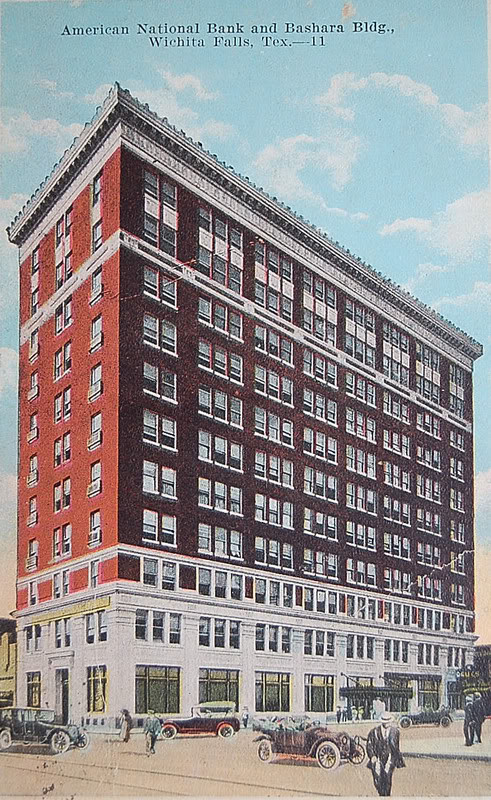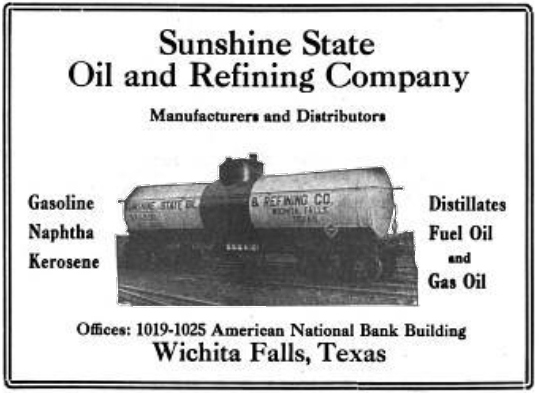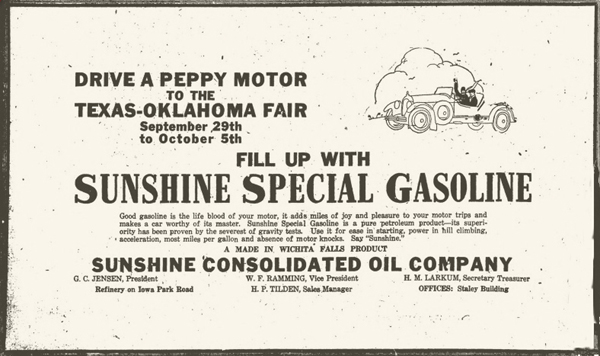At the start of the 20th century, a growing number of Mid-Continent oilfields began their long history of oil discoveries. With them came the drilling boom and bust cycles of the U.S. petroleum industry. Major oilfield discoveries in North Texas during and after World War I, launched new, inexperienced ventures, including Sunshine State Oil & Refining Company
Although oil wealth would helped build Wichita Falls schools, infrastructure, hotels, banks, churches, and civic pride, competition increasingly made drilling prospects hard to come by. Oilfield equipment costs rose as excessive production lowered oil prices.
New oil exploration and production companies often arrived too late and went bankrupt without drilling single well. This did not discourage the rush for new investors (see Exploiting North Texas Fever).

A 1918 oil discovery near Wichita Falls joined earlier discoveries at Electra (1911) and Ranger (1917) to make Texas a worldwide leader in petroleum production.
The Texas Panhandle oil drilling boom began when the giant Ranger oilfield was discovered in October 1917 near Electra — where a 1911 shallow oilfield discovery already had attracted drillers. The “Roaring Ranger” well alone reached a daily production of 1,700 barrels of oil. The giant oilfield helped fuel the Allies’ victory in World War I.
Meanwhile, Conrad Hilton, who visited the Ranger area intending to buy a bank, saw the crowds of oilfield roughnecks and bought his first motel in nearby Cisco instead — learn more in Oil Boom Brings First Hilton Hotel.
Boom Town Burkburnett
Just outside Wichita Falls, at Burkburnett on July 29, 1918, a wildcat well erupted on S.L. Fowler’s farm just north of Wichita Falls near the Red River border with Oklahoma.
The new drilling boom made Burkburnett yet another famous American boom town. Two decades later it inspired the popular 1940 motion picture, “Boom Town,” which won an Academy Award. The oilfield drama featured Clark Gable (himself a former Oklahoma roughneck), Spencer Tracy, Claudette Colbert and Hedy Lamarr.
Even prior to the Burkburnett discovery, North Texas oilfields were producing half of all the state’s oil. Wichita Falls prospered and the town’s railroad line expanded. Refineries began to appear in 1915. That year Wichita County reported 1,025 producing wells.
In 1920 there were 47 factories within Wichita Falls. One year later the Wichita Falls and Southern Railroad Company added an extension for trains between Wichita Falls, Ranger and Fort Worth.
Sunshine State Oil & Refining
Among those rushing to the region’s boom towns was Sunshine State Oil & Refining Company, which incorporated in New Mexico on April 21, 1917. The new company set up its main operations in Wichita Falls capitalized at only $300,000.
Although Wichita Falls already hosted no less than nine competing independent refineries, the company built its own 3.5 miles north of town with an initial capacity of 1,250 barrels of oil a day that grew to 2,500 barrels of oil a day.
By 1920, Sunshine State Oil & Refining had increased capitalization to $650,000 and secured ownership of a 45-mile pipeline to connect with oil producers in the Burkburnett and Kemp-Munger-Allen fields.

Sunshine State Oil & Refining Company had offices in the American National Bank Building in Wichita Falls, Texas.
By July 1922 the company marketed its brand of gasoline and kerosene in Wichita Falls, Burkburnett, Electra, and Gainsville. It also explored opportunities in Eddy and Chavez counties in New Mexico to secure further oil supplies.
The company sold its finished products, principally gasoline and kerosene, in railroad tank cars and managed a fleet that grew from 50 cars to 150 cars. “Manufacturers and Distributors – Gasolene, Naptha, Kerosene Distillates, Fuel Oil and Gas Oils,” proclaimed advertisements with the registered trade name of “Sunshine Special” for products.
Sunshine State Oil & Refining Company was reported to pay 100 percent dividends – but those dividends were paid in shares of company stock. To raise money, the company increased capitalization again and issued more stock.
However, a refining company’s margin for success was inevitably linked to the cost of crude oil and the price of refined petroleum products.

Sunshine State Oil & Refining sold its finished products in railroad tank cars and managed a fleet that grew from 50 cars to 150 cars.
Small independents faced additional challenges, as Sunshine State Oil & Refining Company President George C. Jensen would later note:
“The larger companies will pay posted price and the only way that the independent refineries are able to buy crude oil is to offer a large bonus, in some cases as much as 40 cents per barrel premium over prices paid by Standard Oil,” Jensen complained to Petroleum Magazine’s “Open Forum” readers. “They consequently cannot make a fair profit on refined products.”
Under these and other market pressures, Sunshine State Oil & Refining Company’s refinery began to operate well below capacity.
Sunshine sets in North Texas
As the drilling industry and the refineries competed, Wichita Falls prospered, thanks to “Black Gold.” The city added a municipal auditorium in 1927 and an airline passenger service in 1928 – the same year the city’s first commercial broadcasting station, KGKO, was established.
However, as early as July 1924 Sunshine State Oil & Refining Company was struggling with debt. The company issued more stock to raise capitalization to $1.5 million and in an agreement with shareholders changed its name to Sunshine Consolidated Oil Company.
Shareholders had to exchange their old stock certificates for the new Sunshine Consolidated Oil shares. The old Sunshine certificates were canceled. Efforts to sell new shares on the New York “curb market” did not fare well.

“Say Sunshine” advises this card for newly renamed but still financially troubled Sunshine State Oil & Refining Company and its “made in Wichita Falls product.”
As fundraising efforts failed, creditors forced the renamed company into receivership, which was contested but ultimately adjudicated by the 89th District Court in Texas. Assets were sold off to pay creditors. By November 5, 1925, the Corsicana Daily Sun reported:
A sale involving a cash consideration of $159,000 was consummated in the Wichita Falls oil district Wednesday when Bridwell & Heydrick closed a deal with receiver of the Sunshine Consolidated Oil Company whereby a number of leases in the Sunshine State and Freeman Hampton pools of Archer county changed hands.
After an intense and competitive seven years in business, Sunshine/Consolidated Oil Company failed, joining other oilfield ventures in the high-risk business of petroleum exploration, production and refining. The industry’s boom and bust cycles continue to this day.
North Texas petroleum prosperity began on April 1, 1911, when geyser of oil erupted at the Clayco No. 1 well at Electra,which would later be awarded the title of “ Pump Jack Capital of Texas.”
More stories of many exploration companies trying to join petroleum booms (and avoid busts) can be found in an updated series of research in Is my Old Oil Stock worth Anything?
_______________________
Recommended Reading: Trek of the Oil Finders: A History of Exploration for Petroleum (1975); The Prize: The Epic Quest for Oil, Money & Power (1991); Myth, Legend, Reality: Edwin Laurentine Drake and the Early Oil Industry (2009). Your Amazon purchase benefits the American Oil & Gas Historical Society. As an Amazon Associate, AOGHS earns a commission from qualifying purchases.
_______________________
The American Oil & Gas Historical Society preserves U.S. petroleum history. Join today as an AOGHS annual supporting member. Help maintain this energy education website and expand historical research. For more information, contact bawells@aoghs.org. Copyright © 2022 Bruce A. Wells. All rights reserved.
Citation Information – Article Title: “Sunshine State Oil & Refining Company.” Authors: B.A. Wells and K.L. Wells. Website Name: American Oil & Gas Historical Society. URL: https://aoghs.org/old-oil-stocks/sunshine-state-oil-refining-company. Last Updated: August 2, 2022. Original Published Date: July 22, 2018.


